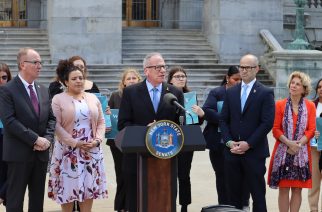
Sen. James Tedisco and Assemblywoman Mary Beth Walsh and eight county clerks held a press conference in Clifton Park on September 4, 2019 to voice their opposition to plans to replace older license plates at a cost of $25 per vehicle.
A growing number of Republican lawmakers and county clerks are voicing opposition to a plan to update license plates on millions of cars and trucks in New York.
On August 19, Gov. Andrew Cuomo announced plans to update state license plates beginning in April 2020 to replace the original blue and white plates — many of which are more than 10 years old — and to stop issuing the newer gold plates once the new ones become available. The need for change stems from decaying and fading plates that are unreadable by license plate readers that are used by police, red light cameras and cashless tolling systems.
New Yorkers had the chance to vote on new designs on the governor’s web page and at the State Fair in August. The new design is expected to be announced soon.
Sen. James Tedisco, R-Glenville, and Assemblywoman Mary Beth Walsh, R-Ballston, joined eight county clerks who oversee local Department of Motor Vehicle offices to oppose what they call the license plate “cash grab.”
Beginning April 1, 2020, the mandatory renewal fee could charge millions of motorists as much as $25 to obtain a new license plate and an additional $20 to keep their current license plate number. However, in recent days, the Governor’s Office has said the Legislature could develop a system to inspect old license plates, and if they are still readable by police and cashless tolling stations, would not need to be replaced.
The Governor’s Office estimates there are more than 3 million license plates that are over 10 years old that would need to be inspected under the plan, and if they are no longer readable, would need to be replaced. Replacing 3 million plates at $25 a set could generate more than $70 million. It is unclear how much of that revenue would be needed to produce the new plates.
Critics of the plan are calling it a new tax on New Yorkers.
“Another day, another tax in New York state,” Walsh said. “Governor Cuomo’s push for new license plates is just another greedy money-grab by the state to take money out of the pockets of our hard-working families and collect more personal data. If these new plates are necessary to improve detection in cashless toll booths and red light cameras, then the state should be covering the costs”

Tedisco and Walsh have the backing of eight county clerks in their districts who oppose the plan. They want to know how the estimated $70 million will be spent, and why the current license plates deteriorated so quickly.
Saratoga County Clerk Craig Hayner; Rensselaer County Clerk Frank Merola; Herkimer County Clerk Sylvia Rowan; Columbia County Clerk Holly Tanner; Warren County Clerk Pamela Vogel; Fulton County Clerk Linda Kollar; Hamilton County Clerk Jane Zarecki; and Essex County Clerk Joseph Provoncha are all supporting Tedisco and Walsh’s call for a public hearing this fall on this issue.
“The resistance to Governor Cuomo’s highway heist to raise license plate fees on millions of motorists is growing and it starts right at the front offices of the people on the ground who actually will have to administer this $70 million cash grab by the state: our local county clerks,” Tedisco said. “The $45 license plate tax is a bad idea. It’s not necessary and the governor should listen to the overwhelming chorus of people who are outraged by it and do the right thing by revoking it.”
Sen. Tedisco has been one of the most vocal opponents of the plan. He created an online petition for New Yorkers to sign and he also filed a Freedom of Information letter with the DMV seeking information about the estimated cost of replacing 3 million older plates. Additionally, Tedisco has asked Senate Transportation Committee Chair Tim Kennedy, D-Buffalo, to schedule a public hearing on the issue this fall.
The senator maintains that the cost of replacing 3 million plates will be far less than the $70 million that will be generated if the state charges a $25 replacement fee on the number of outdated plates officials say are more than 10 years old. That $70 million in revenue does not include the $20 fee that motorists would have to pay if they want to keep their current plate number, so total revenue could end up being much higher.
New York State DMV Commissioner Mark Schroeder says a key goal of issuing new plates is to make sure they can be read by electronic tolling devices on highways and bridges as the state looks to move completely to a cashless tolling system.
Schroeder said if a license plate is damaged or the reflective coating is degraded, cameras will not work and the driver will not be charged the toll. “The revenue loss will be borne by other drivers which is unfair,” he said.
According to Schroeder, the national standard by the American Association of Motor Vehicle Administrators is that 10 years is a license plate’s useful life. It is possible that a plate may still be in good condition after 10 years but that determination would need to be made on a plate by plate basis after inspection.
“If the Legislature can agree to a cost effective and practical plate inspection mechanism to determine what plates are still in good operating condition after the 10-year life, and thus do not need to be replaced, we would welcome the opportunity to be cooperative.
“The 10 year life replacement program does not go into effect until next April so we have time to work with the legislature to explore alternatives,” Schroeder said. “We support reducing costs wherever possible.”
The Governor’s Office says it hopes to work with the Legislature in the next session to develop a system by which motorists can keep their current plates if — following an inspection — they are deemed readable by police and cashless tolling stations
The governor’s Senior Advisor, Rich Azzopardi, said Tuesday that,”As the DMV commissioner said weeks ago, this proposal isn’t going forward as we have committed to working with the Legislature to create a plan that ensures plates are readable by law enforcement and cashless tolling systems and creates a process where plates older than 10 years are inspected and, if still readable, can be kept.”









